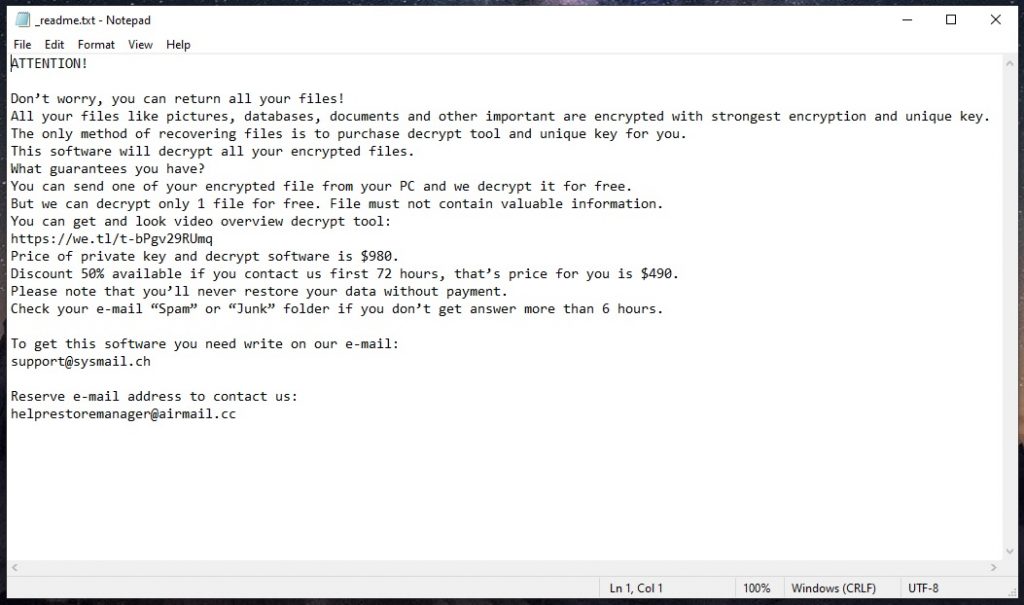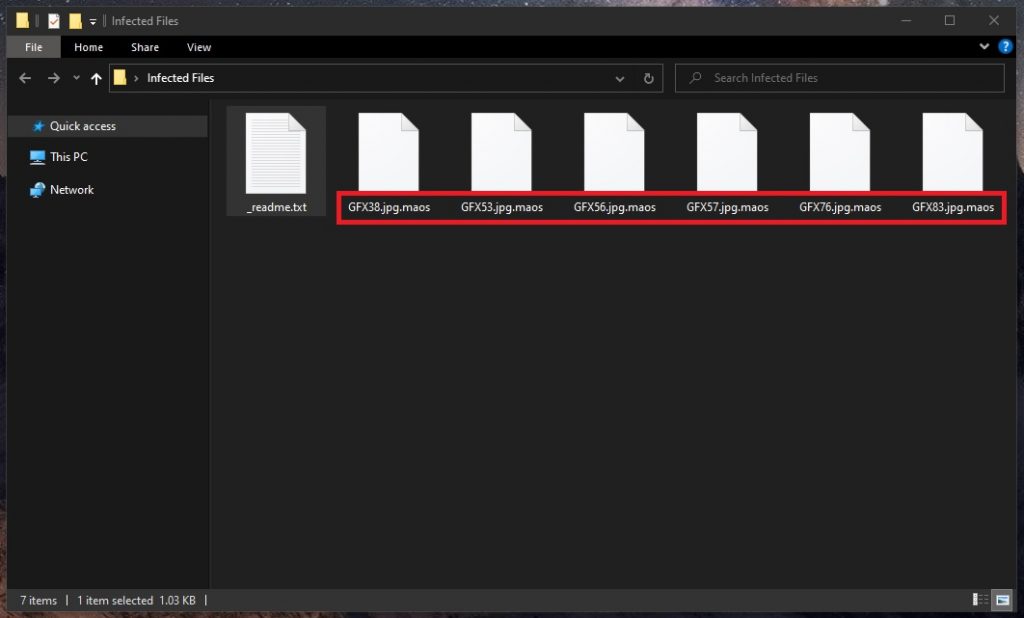
*Maos is a variant of Stop/DJVU. Source of claim SH can remove it.
Maos
Maos is a Ransomware virus that targets your personal data and encrypts it with a complex algorithm. After that, Maos places a ransom-demanding message on the screen and asks for a ransom payment to remove the applied encryption.

Because of its sneaky nature and its oftentimes irreversible consequences, Ransomware is deemed one of the worst kinds of malware. In fact, on this page, we’ve prepared a special removal guide to help the victims of Maos, Manw or Mbtf to remove the virus from their computers and recover their data without paying a ransom to the hackers. But before you move to the actual removal steps, it’s a good idea to educate yourself and learn how to protect your computer in the future.
The Maos virus
The Maos virus is a Ransomware program designed to extort money from Windows users by encrypting their data. What the Maos virus basically does is it keeps certain valuable files hostage and demands a ransom from the victims in the form of a cryptocurrency payment.

You will know that you have been attacked when you see a message on your screen, stating that a list of files on your computer has been encrypted with a secret algorithm that requires a special decryption key to be reversed. To obtain that key, you are required to transfer a fixed amount of money to a given cryptocurrency wallet. The message will likely threaten that, if you fail to do so, you will lose access to your documents, images, databases, and other valuable files for good. Of course, you will find detailed instructions within the message on how to make the transfer to the attackers. The victims are usually given a deadline to release the payment.
In theory, one should receive the key if they pay within the deadline and have all their files restored to their former state. However, there is no guarantee that this will be the case. In some instances, the hackers may double the ransom, send a non-working key, ask for another payment, or simply vanish with the money without giving the victims anything in return.
So, as you can see, just because you gave your hard-earned money to the attackers, it doesn’t mean you will recover your files. Of course, the decision is all yours and no one can stop you from doing what you’ve decided to do, but if you are looking for advice, our “How to Remove” experts suggest you keep the ransom payment as a last resort. Before that, make sure you explore all possible methods to remove the infection and recover your files, including the measures in the guide below.
The Maos file decryption
The Maos file decryption is a process that is supposed to render the encrypted files accessible again. The Maos file decryption process can be activated if a working decryption key is applied to the encrypted files.
If you don’t want to pay the hackers to obtain that key, however, you can restore your files if you have a recent backup of your data. Alternatively, you can try searching for previous versions of files on your computer in system backups. If you’re really fortunate, some files may not have been coded. But first, you will need to remove the Ransomware and all related malware files from your computer to prevent future encryption of recovered or new data. To do so, please follow the steps we have prepared for you in the removal guide below.
SUMMARY:
| Name | Maos |
| Type | Ransomware |
| Danger Level | High (Ransomware is by far the worst threat you can encounter) |
| Data Recovery Tool | Not Available |
| Detection Tool |
We tested that SpyHunter successfully removes Maos* and we recommend downloading it. Manual removal may take hours, it can harm your system if you re not careful, and Maos may reinstall itself at the end if you don’t delete its core files. |
*Maos is a variant of Stop/DJVU. Source of claim SH can remove it.
Remove Maos Ransomware

Some of the steps will likely require you to exit the page. Bookmark it for later reference.
Reboot in Safe Mode (use this guide if you don’t know how to do it).

WARNING! READ CAREFULLY BEFORE PROCEEDING!
*Maos is a variant of Stop/DJVU. Source of claim SH can remove it.
Press CTRL + SHIFT + ESC at the same time and go to the Processes Tab. Try to determine which processes are dangerous.

Right click on each of them and select Open File Location. Then scan the files with our free online virus scanner:

After you open their folder, end the processes that are infected, then delete their folders.
Note: If you are sure something is part of the infection – delete it, even if the scanner doesn’t flag it. No anti-virus program can detect all infections.

Hold the Start Key and R – copy + paste the following and click OK:
notepad %windir%/system32/Drivers/etc/hosts
A new file will open. If you are hacked, there will be a bunch of other IPs connected to you at the bottom. Look at the image below:

If there are suspicious IPs below “Localhost” – write to us in the comments.
Type msconfig in the search field and hit enter. A window will pop-up:

Go in Startup —> Uncheck entries that have “Unknown” as Manufacturer.
- Please note that ransomware may even include a fake Manufacturer name to its process. Make sure you check out every process here is legitimate.

Type Regedit in the windows search field and press Enter. Once inside, press CTRL and F together and type the virus’s Name.
Search for the ransomware in your registries and delete the entries. Be extremely careful – you can damage your system if you delete entries not related to the ransomware.
Type each of the following in the Windows Search Field:
- %AppData%
- %LocalAppData%
- %ProgramData%
- %WinDir%
- %Temp%
Delete everything in Temp. The rest just check out for anything recently added. Remember to leave us a comment if you run into any trouble!

How to Decrypt Maos files
To begin the file recovery procеss, you must first detect the ransomware variant you are up against and remove it. For that, you need to carefully follow the removal steps outlined above, as well as run a system scan with a professional anti-virus tool or an online virus scanner.
Once the ransomware has been totally removed from your computer, and there are no other infections, take a look at the inaccessible files. Files encrypted by different variants of ransomware may be identified by their file extensions.
New Djvu Ransomware
The latest ransomware variant to emerge from the Djvu family is called STOP Djvu, and it’s hitting users in various countries worldwide. Files encrypted by this variant will typically have the .Maos extension.
Users infected with this new variant may have a hard time dealing with the infection. However, if an offline key was used to encrypt the data, it is possible to recover the original files. This is a welcome relief, since keeping up with new ransomware threats is a very challenging task. The good news is that, there is decryption software out there that you may use to try a data recovery. Just click the link below in your browser and hit the download button to save the executable file on your computer:
https://www.emsisoft.com/ransomware-decryption-tools/stop-djvu
Launch the decryptor with administrative privileges and click on “Yes” when prompted. Please take the time to read the license agreement and the brief instructions for use before moving further. Use the button labeled “Decrypt” to try decrypting the encrypted information. Bear in mind that the tool may not be able to decode files that have been encrypted online or with an unknown offline key.

Leave a Reply